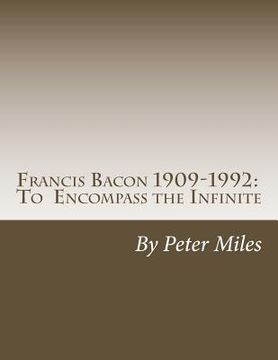Reseña del libro "Francis Bacon: To Encompass the Infinite (en Inglés)"
Although this book concerns Francis Bacon (1909-1992) it also addresses other issues. Firstly this is a critique that includes a survey of all Bacon's work and not just a selection. Of prime importance, for me, is the status of artistic cognition with respect to understanding the nature of the world we inhabit. At present materialistic scientific theories and postulations occupy the high ground in defining what reality is, whether that be the human being or the Universe. It is simply not countenanced by the proponents of this abstract, intellectual thinking that Imaginative Thinking can be anything other than ungoverned fantasy, and that the Arts are no more than a luxury to be indulged because of their entertainment value. This attitude, I argue, is engendered by an incorrect understanding of how our consciousness functions, which is at present in a dangerous state of imbalance due to the bias towards abstract, intellectual thinking. In relatively modern times it is Johann Wolfgang von Goethe (1749-1832) who first demonstrated that Intellectual Thinking when combined with Imaginative Thinking produces a richer fuller understanding of what may loosely be called reality, than Intellectual thinking alone. It is virtually unknown in this country that Goethe during his life-time was a highly respected Natural Scientist. This leads on to the question of what was it that an artist of Bacon's calibre actually perceived as the basis for his production? In all my research I have found no convincing accounts as to why his images appear the way they do. There is heated debate over the significance of his work but very little explanation of why he created in a style that is manifestly his own, i.e. there are no precursors that can be meaningfully applied to his images for explanatory purposes. Bacon presents the paradox of being firmly entrenched within the traditions of Western Figurative painting whilst simultaneously presenting a vision of the human being that is contrary to that tradition and all its assumptions. I argue, and demonstrate, in my book that Bacon had unusual perceptive abilities, and so I looked to Esotericism. My research eventually led me to Rudolf Steiner (1861-1925). The value for me of Steiner's work is that it presents an image that treats the whole of our being as real and of equal worth. In this context the treatment of qualities related to phenomena, such as touch and taste, as secondary to Number, Weight and Measure is a grievous error, and this is precisely the point where the downgrading of Artistic Cognition is so pernicious, for the Arts activate the totality of our ability to sense, thereby, promoting a greater understanding of what we are as a human being. This downgrading of Artistic Cognition has obfuscated recognition of the importance of the fact that creative use of our hands spurs brain development, and, as such, is a potent evolutionary factor. What are the attributes that Bacon's images display that so convince me that Bacon was able to perceive levels of existence, invisible to a consciousness based upon the intellect alone? Rudolf Steiner first suggested that it was possible to deploy Projective Geometry to gain an insight into the modus operandi of what are known as natural forces. All forces operate in the same manner and this is given a formal systematisation through the principles of Projective Geometry. At present the focus is almost exclusively upon those forces that have a dramatic and observable effect upon our lives. There is, however, a force that is given scant attention even though its effects are blatantly obvious, and that is the force of growth, without which there would be no living thing in existence. For the purposes here I will name this as the 'force of life', attributes of which, such as expansion and contraction are readily to be observed as elements pertaining to Bacon's iconography.

